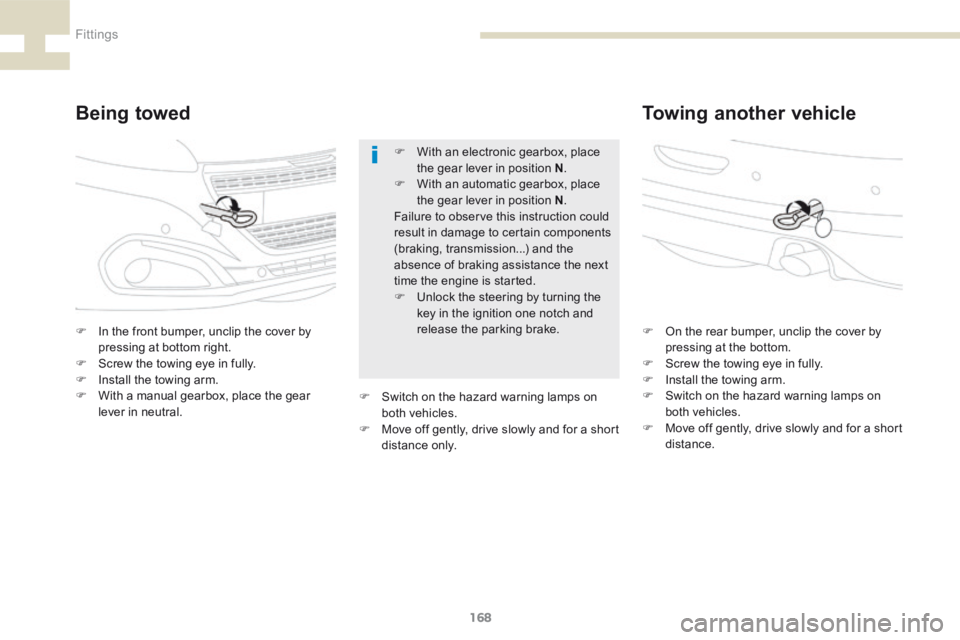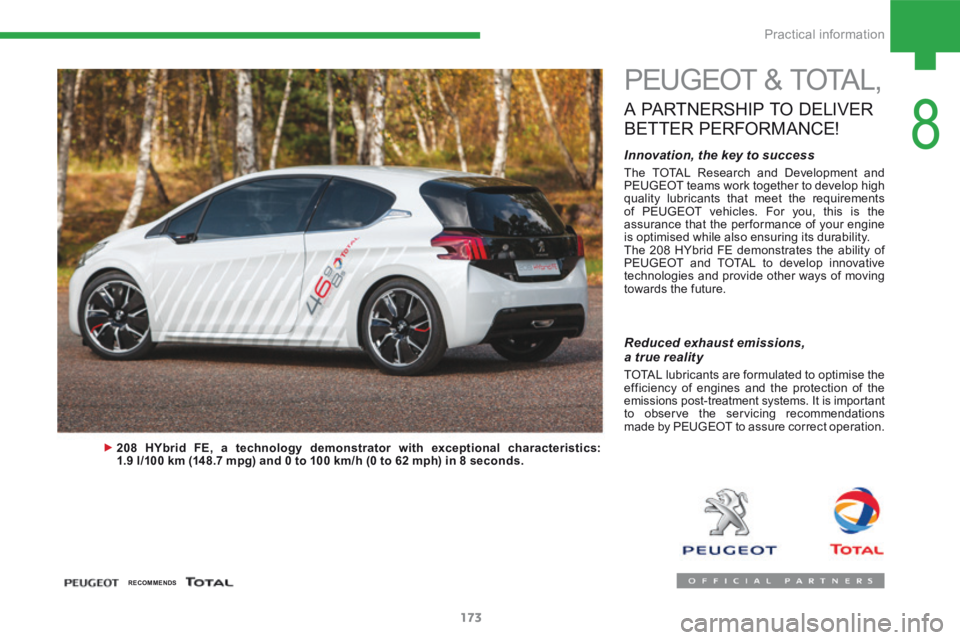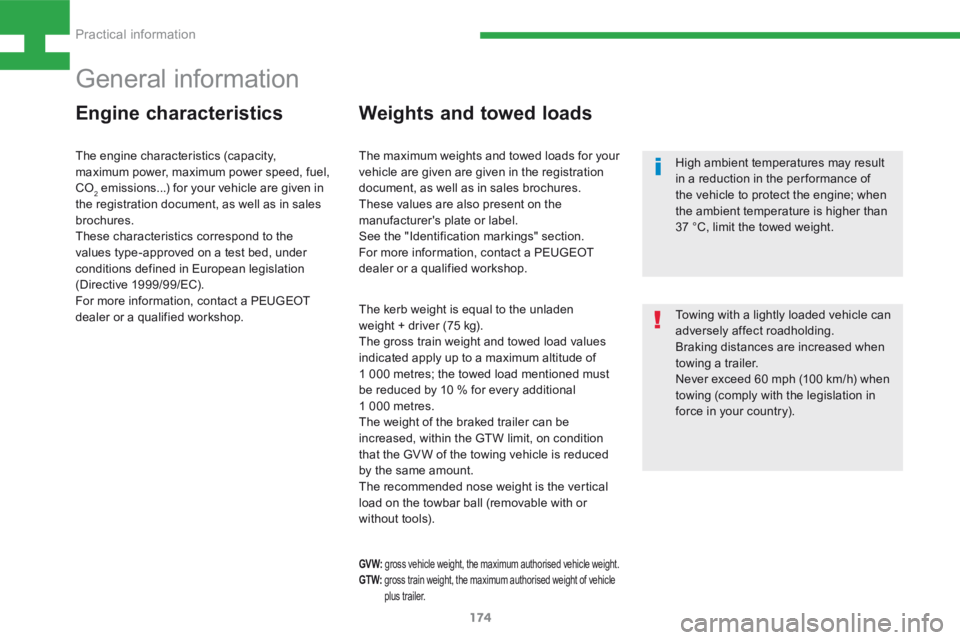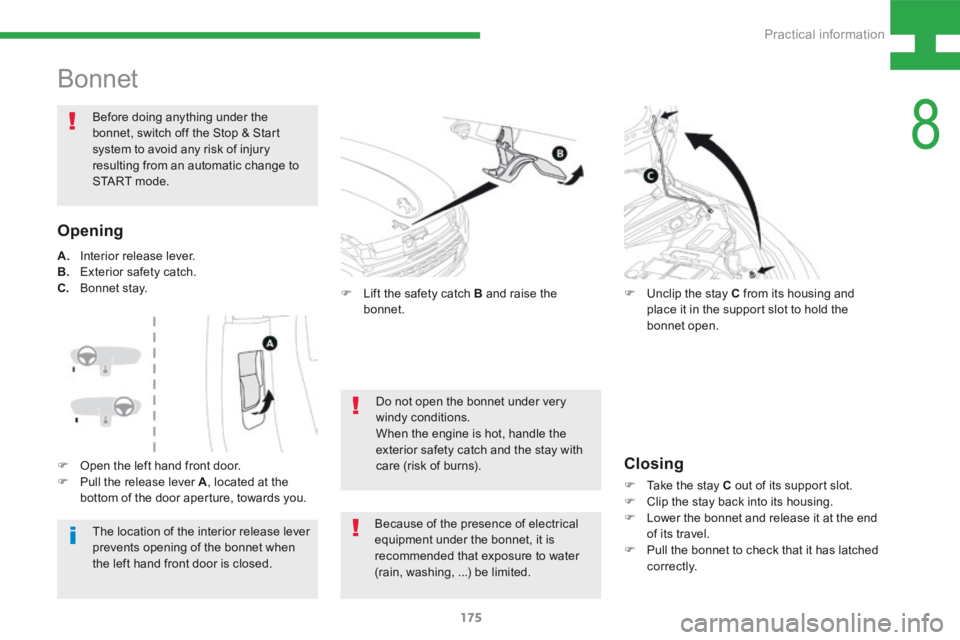Page 170 of 341

168
208_en_Chap07_ Amenagements_ed01-2015
Being towedTowing another vehicle
F In the front bumper, unclip the cover by
pressing at bottom right.
F Screw the towing eye in fully.
F Install the towing arm.
F With a manual gearbox, place the gear
lever in neutral. F
On the rear bumper, unclip the cover by
pressing at the bottom.
F Screw the towing eye in fully.
F Install the towing arm.
F Switch on the hazard warning lamps on
both vehicles.
F Move off gently, drive slowly and for a short
distance.
F
With an electronic gearbox, place
the gear lever in position N .
F With an automatic gearbox, place
the gear lever in position N .
Failure to observe this instruction could
result in damage to certain components
(braking, transmission...) and the
absence of braking assistance the next
time the engine is started.
F Unlock the steering by turning the
key in the ignition one notch and
release the parking brake.
F Switch on the hazard warning lamps on
both vehicles.
F Move off gently, drive slowly and for a short
distance only.
Fittings
Page 175 of 341

173
208_en_Chap08_Informations-pratiques_ed01-2015
PEUGEOT & TOTAL,
A PARTNERSHIP TO DELIVER
BETTER PERFORMANCE !
Innovation, the key to success
The TOTAL Research and Development and
PEUGEOT teams work together to develop high
quality lubricants that meet the requirements
of PEUGEOT vehicles. For you, this is the
assurance that the performance of your engine
is optimised while also ensuring its durability.
The 208 HYbrid FE demonstrates the ability of
PEUGEOT and TOTAL to develop innovative
technologies and provide other ways of moving
towards the future.
208 HYbrid FE, a technology demonstrator with exceptional characteristics:
1.9 l/100 km (148.7 mpg) and 0 to 100 km/h (0 to 62 mph) in 8 seconds.
Reduced exhaust emissions,
a true reality
TOTAL lubricants are formulated to optimise the
efficiency of engines and the protection of the
emissions post-treatment systems. It is important to observe the servicing recommendations
made by PEUGEOT to assure correct operation.
RECOMMENDS
8
Practical information
Page 176 of 341

174
208_en_Chap08_Informations-pratiques_ed01-2015
General information
Engine characteristicsWeights and towed loads
The kerb weight is equal to the unladen
weight + driver (75 kg).
The gross train weight and towed load values
indicated apply up to a maximum altitude of
1 000 metres; the towed load mentioned must
be reduced by 10 % for every additional
1 000 metres.
The weight of the braked trailer can be
increased, within the GTW limit, on condition
that the GV W of the towing vehicle is reduced
by the same amount.
The recommended nose weight is the vertical
load on the towbar ball (removable with or
without tools). High ambient temperatures may result
in a reduction in the per formance of
the vehicle to protect the engine; when
the ambient temperature is higher than
37 °C, limit the towed weight.
Towing with a lightly loaded vehicle can
adversely affect roadholding.
Braking distances are increased when
towing a trailer.
Never exceed 60 mph (100 km/h) when
towing (comply with the legislation in
force in your country).
GV W:
gross vehicle weight, the maximum authorised vehicle weight.
GT W: gross train weight, the maximum authorised weight of vehicle
plus trailer.
The engine characteristics (capacity,
maximum power, maximum power speed, fuel,
CO
2 emissions...) for your vehicle are given in
the registration document, as well as in sales
brochures.
These characteristics correspond to the
values type-approved on a test bed, under
conditions defined in European legislation
(Directive 1999/99/EC).
For more information, contact a PEUGEOT
dealer or a qualified workshop. The maximum weights and towed loads for your
vehicle are given are given in the registration
document, as well as in sales brochures.
These values are also present on the
manufacturer's plate or label.
See the "Identification markings" section.
For more information, contact a PEUGEOT
dealer or a qualified workshop.
Practical information
Page 177 of 341

175
208_en_Chap08_Informations-pratiques_ed01-2015
Bonnet
The location of the interior release lever
prevents opening of the bonnet when
the left hand front door is closed.
Before doing anything under the
bonnet, switch off the Stop & Start
system to avoid any risk of injury
resulting from an automatic change to
S TA R T m o d e .
Closing
F
Take the stay C out of its support slot.
F Clip the stay back into its housing.
F Lower the bonnet and release it at the end
of its travel.
F Pull the bonnet to check that it has latched
c o r r e c t l y.
F
Unclip the stay C from its housing and
place it in the support slot to hold the
bonnet open.
Do not open the bonnet under very
windy conditions.
When the engine is hot, handle the
exterior safety catch and the stay with
care (risk of burns).
Opening
F Lift the safety catch B and raise the
bonnet.
A.
Interior release lever.
B. Exterior safety catch.
C. B o n n et st ay.
Because of the presence of electrical
equipment under the bonnet, it is
recommended that exposure to water
(rain, washing, ...) be limited.
F
Open the left hand front door.
F Pull the release lever A , located at the
bottom of the door aperture, towards you.
8
Practical information
Page 178 of 341
176
208_en_Chap08_Informations-pratiques_ed01-2015
The various caps and covers allow access for
checking the levels of the various fluids and for
replacing certain components.
Petrol
1. Screenwash reservoir.
2. Coolant header tank.
3. Brake fluid reservoir.
4. Battery / Fuses.
5. Fusebox.
6. A i r f i l t e r.
7. Engine oil dipstick.
8. Engine oil filler cap.
Take care when working under the
bonnet, as certain areas of the engine
may be extremely hot (risk of burns) and
the cooling fan could start at any time
(even with the ignition off).
Checking levels
Check the levels regularly, in line with the
manufacturer's service schedule. Top them up
if necessary, unless otherwise indicated.
If a level drops significantly, have the
corresponding system checked by a PEUGEOT
dealer or a qualified workshop.
Practical information
Page 179 of 341
177
208_en_Chap08_Informations-pratiques_ed01-2015
The various caps and covers allow access for
checking the levels of the various fluids, for
replacing certain components and for priming
the fuel system.
Diesel
1. Screenwash reservoir.
2. Coolant header tank.
3. Brake fluid reservoir.
4. Battery / Fuses.
5. Fusebox.
6. A i r f i l t e r.
7. Engine oil dipstick.
8. Engine oil filler cap.
9. Priming pump (depending on engine).
The AdBlue
® additive tank filler is located in the
boot below the spare wheel.
Take care when working under the
bonnet, as certain areas of the engine
may be extremely hot (risk of burns) and
the cooling fan could start at any time
(even with the ignition off).
Checking levels
Check the levels regularly, in line with the
manufacturer's service schedule. Top them up
if necessary, unless otherwise indicated.
If a level drops significantly, have the
corresponding system checked by a PEUGEOT
dealer or a qualified workshop.
8
Practical information
Page 180 of 341
178
208_en_Chap08_Informations-pratiques_ed01-2015
EngineGearbox SpeedsEngine oil capacity*
(litres) Unbraked trailer (kg) Recommended nose
weight (kg)
1.0 PureTech 68 Manual53 .13450 / 600** 30
1.2 PureTech 82 Manual
53 .13 520 46
Electronic 53 .13 520 46
1.2 PureTech 82 S&S Electronic53 .13 500 46
1.4 VTi 95 LPG Manual54.25 570 46
1.2 PureTech 110 S&S Manual5---
1.6 VTi 120 Manual
54.25 580 46
Automatic 44.25 580 46
1.6 THP 155 Manual 64.25 580 46
1.6 THP 200 hp Manual64.25 580 46
1.6 THP 208 S&S Manual64.25 580 46
* Capacity with oil filter replacement.
** Affaire version.
Petrol engines
Practical information
Page 181 of 341
179
208_en_Chap08_Informations-pratiques_ed01-2015
* Capacity with oil filter replacement.
** Affaire version.
Diesel engines
EngineGearbox SpeedsEngine oil capacity*
(litres) Unbraked trailer (kg) Recommended nose
weight (kg)
1.4 HDi 68 Manual 53.75400 / 600** 29
1.4 e- HDi 68 Electronic 53.75500 / 600** 29
1.6 HDi 75 Manual 53.75 --
1.6 HDi 92 Manual 53.75 --
1.6 e- HDi 92 Manual
53.75570 / 600** 46
Electronic 63.75 580 46
1.6 e- HDi 115 Manual63.75 580 46
1.6 BlueHDi 120 Manual6---
8
Practical information